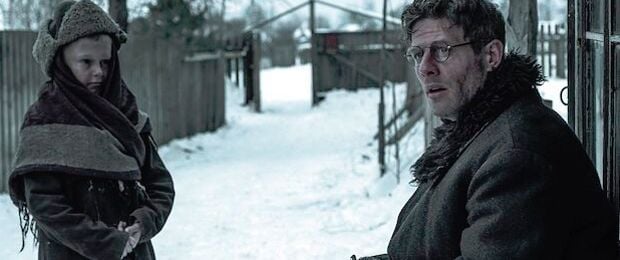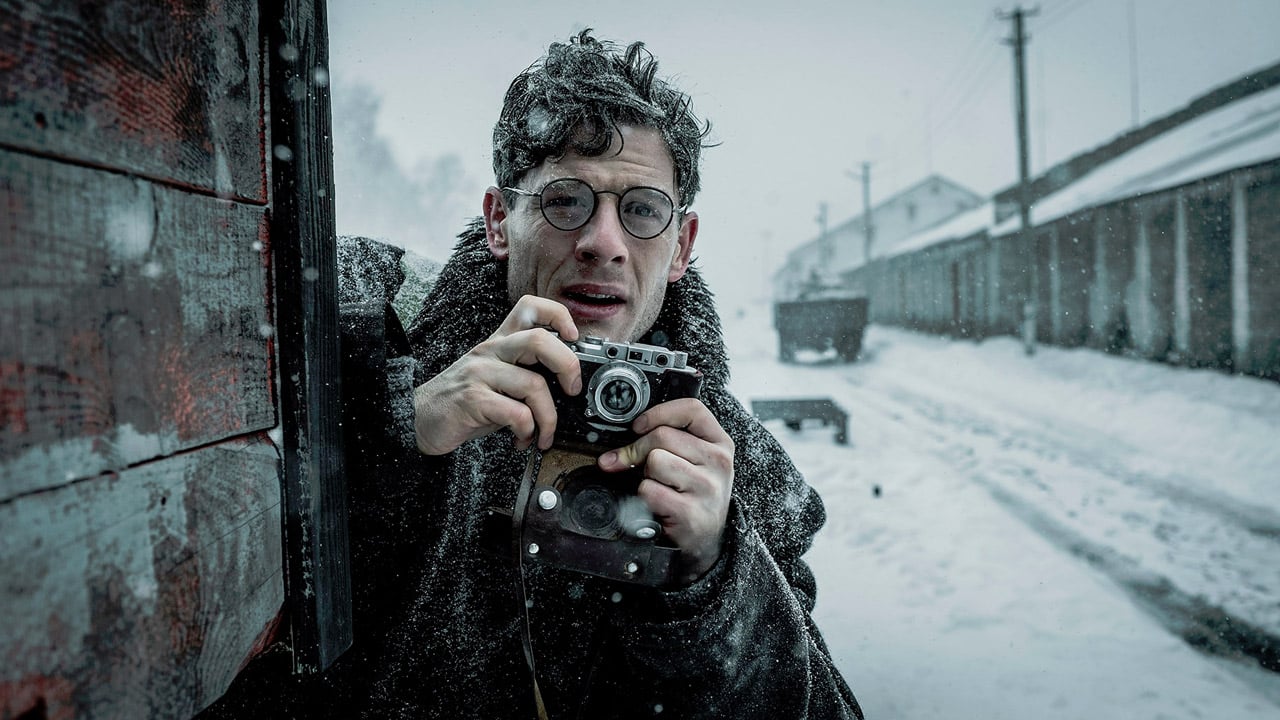This Tuesday evening, French MPs almost unanimously adopted a text declaring the Soviet-organized famine in Ukraine between 1931 and 1933, which killed 4 million Ukrainians, as genocide.
The decision, which was welcomed by President Volodymyr Zelensky, had a highly political and symbolic resonance in the context of the Russia-Ukraine war. Deputies ended a 17-year hiatus: In 2006, the draft law was drafted to recognize the genocide. But this issue was not discussed again.
Released in 2020 and directed by the brilliant Polish-born director Agnieszka Holland, Stalin’s Shadow is a still very rare echo of this mass crime, one of the most horrific of the 20th century. The memory is so poignant that it also carries the seeds of ongoing conflict between the two countries.
In Stalin’s shadowThe director narrates part of the authentic life of British journalist Gareth Jones, who risked his life in 1933 to report what was a genocide organized by Stalin in Ukraine, known as the Holodomor.
Alongside the Berlin, Dinard (British film) and Pesak (historical film) festivals, the film has a pretty solid cast, starting with James Norton in the title role, supported by Vanessa Kirby and the always flawless Peter Sarsgaard.
“With the screenwriter, Andrea ChalupaWe wanted to describe in an evocative way, with all simplicity and without detours, the mechanics of Jones, who successively goes through all the circles of hell, collides with his idealism, youth and his bravery with the cruel reality.
No journalistic or informative evidence, no sentimental blackmail or obvious high-end. No one wanted to hear the truth about Stalin’s brutality that Jones was exposing. explained the film director.
The British, like other Western chancelleries, had no interest in it. “The truth about Soviet reality, like the truth about the Holocaust, was suppressed by the politically and morally corrupt West.” Run the director.
Transgenerational Suffering
In fact, the memory of this period is so painful for Ukraine – even transgenerational suffering – that it is one of the reasons (and obviously not the only one, it is necessary to insist) Collaboration of some Ukrainians with the Nazis, before and during World War II. Especially with the pitiful memory of an ultra-nationalist Stepan Bandera.
A period whose geopolitical expansion can be found in the tension between the country and Russia, which has culminated in recent years with the creation of the Donetsk People’s Republic and the armed conflict in Donbass, indirectly supported by Moscow. And now the war.
“The unspeakable reality of those years remains relevant in Ukraine, which is at war with Stalin’s successors, and in Europe, which is troubled by many internal and external threats, which cannot face the truth and unite to defend its values.” The headmaster said clearly.
Beyond the scary subject matter, the film also finds a unique resonance with “fake news”, whistleblowers – what was Gareth Jones -, disinformation, media corruption, their lack of meaning or ethics, the cowardice, indifference of governments. people.
Holodomor, genocide by starvation
If the Holocaust is a fact known to the general public, the same cannot be said about the Holodomor. Thus, the term refers to the genocide by starvation that was deliberately organized by Stalin in Ukraine. In two years, from the summer of 1931 to the summer of 1933, nearly 7 million Soviets, the vast majority of them peasants, starved to death in the last great peacetime European famine: 4 million in the Ukraine, 1.5. A million in Kazakhstan and the same in Russia.
“Unlike other famines, 1931-1933 was not preceded by a meteorological cataclysm. They were the direct result of a policy of extreme violence: the forced collectivization of the countryside by the Stalinist regime with the dual purpose of “expelling the peasantry, a heavy tribe, necessary for the rapid industrialization of the country and establishing political control over the countryside, which had hitherto remained outside the regime’s ‘value system’.” Nicolas Vert, a French historian specializing in the history of the Soviet Union and currently director of research at the Institute of Contemporary History, explains; The author of the book “The Great Soviet Famine”Published in PUF in 2020.
Worse: since the autumn of 1932, this hunger strike was deliberately intensified by Stalin; The “little father of the people” who is trying to break the resistance of the Ukrainian peasants to collectivization and at the same time eliminate Ukrainian nationalism, which the Moscow authorities believe poses a serious threat to the unity and integrity of the vast territory. USSR.
If today’s Russia is not yesterday’s USSR, About Vladimir PutinHe says to himself “Decided to continue uncompromising fight against Ukrainian nationalists”, Resonance as a disturbing echo.
In 2022, as Ukraine, in the midst of war, commemorated the 90th anniversary of that great famine, historian Nicholas Werth rightly said. at the microphone of France Info In recognition of the genocidal nature of this organized famine, however, the apparent difference in perception between Russian and Ukrainian historians is emphasized. “There is a fundamental disagreement. Russian historians view this episode as a regional variant of the Soviet famine. Ukrainians emphasize its specificity.” He commented.
Famous press conference
On March 31, 1933, on his return to Western Europe, Garrett Jones held a highly publicized press conference in Berlin to an audience of journalists from around the world. His confession surprised the audience.
“I went through the villages and dozens of collective farms. I saw only suffering and tears. This suffering spreads everywhere in Russia, from the Volga to Siberia, from the North of the Caucasus to Central Asia. I went to Center-Chernozem”. Because it was one of the most fertile regions of Russia, and also because most foreign correspondents in Moscow forgot to go there to see for themselves what was happening there.
A communist on the train to whom I asked about the hunger strike denied its existence. I put a bread crouton on the skewer. A peasant who shared our compartment took it as if he hadn’t eaten in days. Then I threw in the orange peel and this peasant ate it.
I spent the night in a village where 200 bulls once grew. Only 6 remained. The peasants ate what was left of the cattle feed. I was told that many of them had already starved to death.
Two soldiers came to arrest the thief. I was advised to avoid driving at night because there are a lot of “hungry” men walking around. “We are waiting for death. But we still have hay left. Go further south. There is nothing left there. Many houses are empty. Their inhabitants are dead,” they told me, crying.

Jones takes aim at home in a published article London Evening Standard March 31, 1933 under the title “Russia under the yoke of hunger”. The article he concluded with the lapidary formula: “The Five Year Plan built many beautiful factories. But it is bread that keeps the factories going; and the Five Year Plan destroyed Russia’s bread basket.”
Far from sharing his views, some colleagues even attacked his conclusions with great violence, such as Walter Durant (played by Peter Sarsgaard in the film), the Moscow correspondent of the prestigious New York Times from 1922 to 1936.
In line with Moscow’s propaganda, he denied the existence of generalized hunger in the region. “Russians are hungry, but not hungry” He named March 31, 1933 in the title; explained that the high death rate was due to diseases related to malnutrition and that only Ukraine was affected by this supply problem.
“Russian and foreign observers have no reason to believe in a humanitarian catastrophe” He dared to write who was the winner of the prestigious Pulitzer Prize in 1932. In 1990, A. New York Times foreign affairs journalist Carl E. Meyer’s editorialadmitted that Durant was the author “Some of the worst stories ever to appear in this paper”whose backlight on the famine in Ukraine was a sad and tragic symbol.

If the country has already faced terrible famines on other occasions, such as in 1921 or 1946-1947, the Holodomor is a key element in the construction of the post-Soviet Ukrainian identity.
In 2006, then-Ukrainian President Viktor Yushchenko signed a law recognizing the Holodomor as an intentional genocide against Ukrainians. In 2008 and 2010, the memorial was then A The National Museum dedicated to the victims of Goldomore born.
Stalin’s shadow, available on VOD as well as DVD/Blu-ray. Also look out for the excellent documentary La case du siècle broadcast last February on France 5 Bloody harvest – 1933, famine in Ukraine, which goes right back to Gareth Jones’ trip to the country, with extremely rare inside footage of the drama in particular. Officially there are only 26 photos… it’s still free to view on the france.tv websiteuntil June 27.
Source: Allocine
Rose James is a Gossipify movie and series reviewer known for her in-depth analysis and unique perspective on the latest releases. With a background in film studies, she provides engaging and informative reviews, and keeps readers up to date with industry trends and emerging talents.






